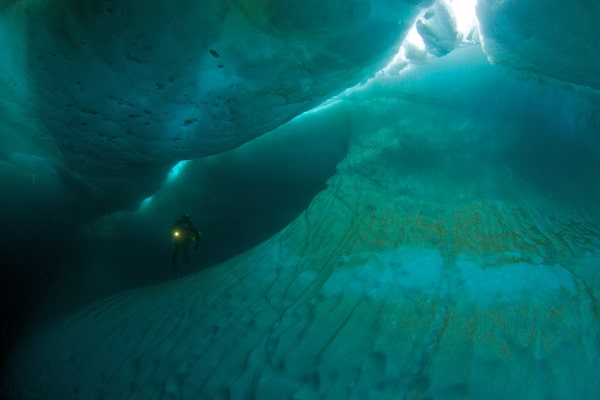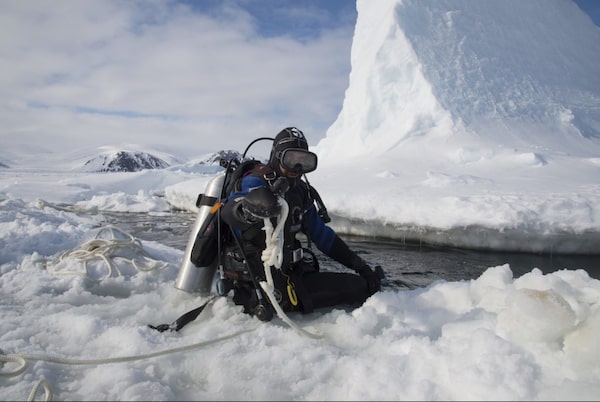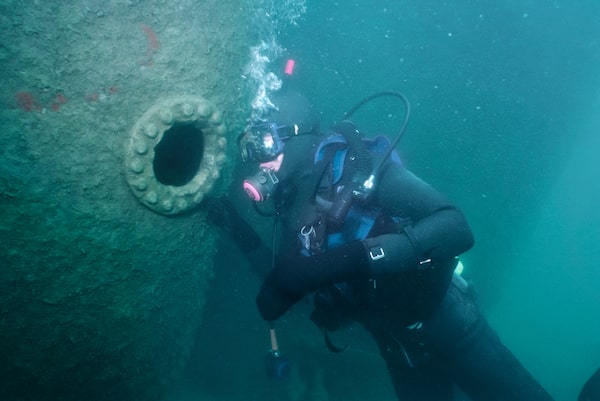
A scuba divers swims through the contours of the ice and icebergs of Canadian Arctic. 'They capture the light in a really unique way, like stained glass in a cathedral,' says Graham Dickson, master diver and owner of Arctic Kingdom.Todd Mintz/Arctic Kingdom
When you want to take the plunge with an underwater adventure, Canada has plenty of diving experiences to offer, from encounters with aquatic wildlife in the north to clear lakes dotted with historic shipwrecks.
Around Baffin Island, scuba divers and snorkellers are transported into an underwater world where they can join seals, whales and narwhals in clear, cold waters and explore the sculptural contours of ancient icebergs.
It’s a magical place that is often under the radar, but not for Graham Dickson, a master diver and owner of Arctic Kingdom. He founded the company almost 25 years ago to specialize in scuba diving trips.
Everything is glowing from the bright sun above and sometimes you hear the sound of whales and seals through the water.
— Graham Dickson, owner of Arctic Kingdom
Though he has dived all over the world, it was the Canadian Arctic that intrigued him the most. “The North is so exotic,” says Dickson. “The wildlife is legendary – the narwhals called the unicorn of the seas, the bowhead whales, the seals, the polar bears… It captured my soul and captivated everyone who visited it. The interest continues to grow to this day.”
Divers can slip into the water and explore the contours of the ice and icebergs frozen in place over the winter. “They capture the light in a really unique way, like stained glass in a cathedral,” he explains. “Everything is glowing from the bright sun above and sometimes you hear the sound of whales and seals through the water. You may also have wildlife coming to investigate you, belugas especially. They’re very curious.”
On the floe edge, where there’s pack ice on one side and the open water of the Arctic Ocean on the other, divers get a sense of how life flourishes with small cod, jellyfish and microorganisms, or perhaps seals and roaming polar bears. Ice divers receive instruction on how to make the most out of their time navigating the environment and beginner snorkellers, also supplied with dry suits, are welcome with as many as two dive trips each day.

Guests of the Baffin Island Dive Safari explore the Arctic above and below the ice, learning about aquatic life such as small cod, jellyfish and seals or viewing polar bears.Arctic Kingdom
Arctic Kingdom offers an eight-day Baffin Island Dive Safari package, which allows up to eight participants to explore the Arctic above and below the ice. Guests fly into Pond Inlet, Nunavut via Ottawa to begin their adventure and stay in a tented safari camp close to the dive sites. To get around, they’ll be transported by snowmobile and qamutik (a traditional Inuit sled). May and June are ideal times, thanks to crystal clear water with visibility of 30 to 50 metres and the arrival of spring when the pack ice starts to break, but summer and fall diving is also popular.
Clients come from all over the world, from Mexico to China and United States, to dive in Canada’s Arctic region. “It’s an incredible life experience for our guests,” says Dickson. “They really fall in love with the Arctic and the Inuit People who share their stories about what it’s like living in the area. I wish that more Canadians could see and appreciate how special our Far North is.”
Further south in Ontario’s Fathom Five National Marine Park, near Tobermory, underwater adventure means understanding an important chapter in Canadian history through a bounty of shipwrecks in the area, which served as a busy aquatic corridor. Many vessels now at the bottom of Lake Huron date from the end of the 1800s into the beginning of the 1900s.
“This was a time when most goods were shipped by boat, and transporting goods west meant sailing through the Great Lakes,” says Ethan Meleg, acting superintendent of Bruce Peninsula National Park and Fathom Five National Marine Park. “Before the advent of modern technology, the many islands and shoals in the waters of Fathom Five presented hazards to navigation.”
The lack of reliable weather forecasting caused many ships to be lost in strong gales that can blow through the region, especially in the fall. They include the steamer W.L. Wetmore, sunk in 1901, and Philo Scoville, a three-masted schooner from 1889. “Natural hazards of the area, combined with the volume of vessel traffic passing through at that time and bad weather, mean wrecks on the lakebed offer a connection to the past – a time when Canada was more remote and travel was dangerous and difficult,” he says.
Fathom Five is Canada’s first national marine conservation area and a remarkable freshwater ecosystem in the heart of the Great Lakes, located in the traditional territory of the Saugeen Ojibway Nation. The region is home to what is called “the scuba diving capital of Canada.” It has earned that reputation for its incredibly clear water, which makes the visibility ideal to see 22 shipwrecks scattered at varying depths. There’s also a vibrant diving community in the town of Tobermory, including dive charters that provide experiences for everyone from novice snorkelers to advanced divers.
Those who come to the area also appreciate what’s above the water line – a rocky landscape with sheer cliffs, limestone caves, three historic lighthouses and flowerpot rock formations carved by nature over time. It makes a beautiful backdrop for a day of exploration. Start your experience by visiting the Parks Canada Visitor Centre or the dive shop in downtown Tobermory. All divers must register and purchase a dive pass prior to diving.
Whether you dive in the Far North or in the heart of Ontario, underwater adventure trips are a thrilling way to plunge deeper into Canada’s natural beauty and aquatic life.

Hundreds of shipwrecks lie in the depths of Ontario’s Great Lakes, many dating back to the late 1800s and the early 1900s.John R. Butterill/Fathom Five Marine Park
If you like that, you’ll love this
- Brockville, Ont. The waters of the St. Lawrence River are perfect for new and novice divers who want to explore shipwrecks. Between Brockville and Rockport, there are 10 wrecks to explore in shallow waters with a low current.
- Bell Island, Nfld. Aquatic creatures are abundant here, including eels, jellyfish and lumpfish, along with an eerie whale graveyard with a massive amount of remains, near a former whale processing plant from the days of commercial fishing.
- Barkley Sound, B.C. Diving on the west side of Vancouver Island is considered one of the best experiences around for marine life, including giant Pacific octopi, sea lions, wolf eels and gill sharks.
- Clear Lake, Alta. This purposefully created dive site has several oddities to keep things interesting. You may come across a sunken airplane and a life-sized ceramic cow. Diving charters nearby can teach newbies to become PADI certified (Professional Association of Diving Instructors).
- West Hawk Lake, Man. About an hour-and-a-half drive from Winnipeg in Whiteshell Provincial Park, West Hawk Lake, the deepest in the province at 121 metres at its centre, was created by a prehistoric meteor impact. Visibility is good, so divers can find items set up for their viewing pleasure, like an underwater picnic table.